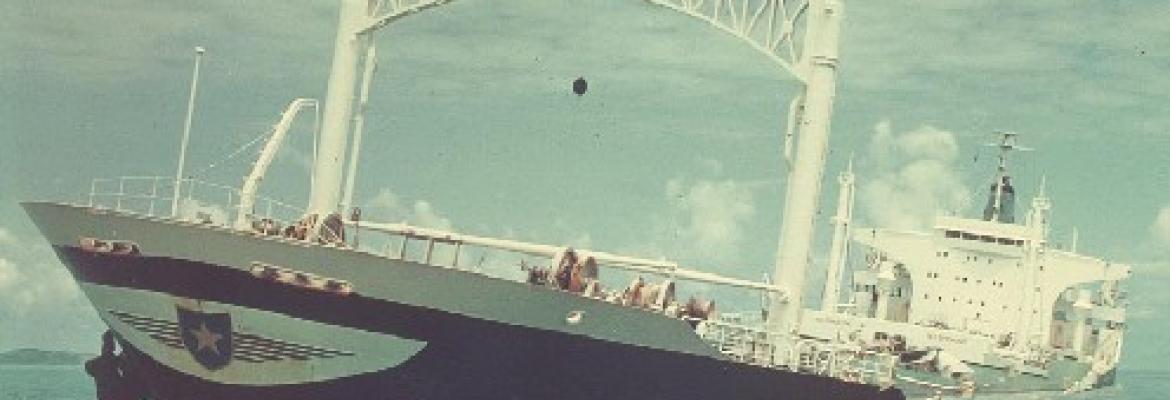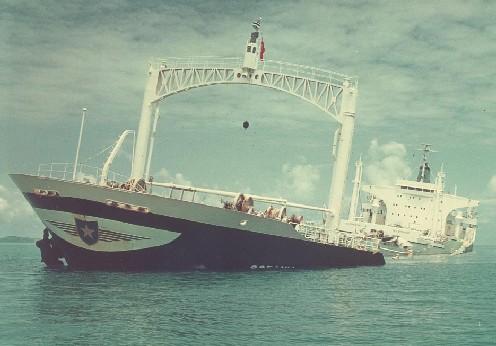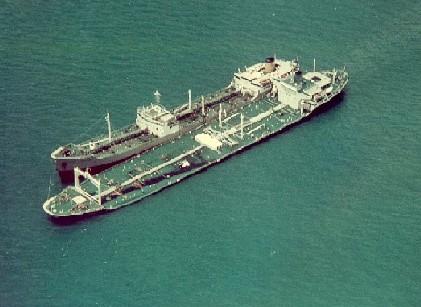
On 3 March 1970, the Liberian-flagged tanker Oceanic Grandeur struck an uncharted rock in Torres Strait while en-route from Dumai, Indonesia, to Brisbane.
The Oceanic Grandeur was carrying approximately 55,000 tonnes of Sumatran crude oil and a marine pilot to navigate through the Strait. Eight of the 15 oil cargo tanks were ruptured and oil was spilt upon impact. The ship reduced speed and anchored five nautical miles to the east, half an hour later. The Oceanic Grandeur then remained at anchor.
As some tanks were interconnected, a total of 12 tanks had taken in seawater and the vessel had a considerable list to port and several hundred feet of the port side deck was awash. The list remained constant and no oil loss occurred for the next three days.
A second substantial spill from the vessel occurred on 10 March during operations to remove the oil―a delicate task which required constant regard for the stability of the vessel.
Reports vary of the total amount of oil spilled, but it has been estimated at around 1100 tonnes. This includes crude oil from the cargo tanks, and a lighter diesolene fuel oil.
The response
The strong tidal currents (up to 6 knots) in the vicinity of the Oceanic Grandeur made it impractical to use booms to contain the oil. The use of absorbent pellets without suitable means of collection (eg booms) and disposal was also rejected since oil would be kept on the surface meaning greater risk of foreshore oiling.
A smaller tanker, Leslie J. Thompson, steaming under ballast bound for Dumai, encountered the Oceanic Grandeur around 9.15 am on 3 March. Noticing the Oceanic Grandeur’s list, the master of the Leslie J. Thompson contacted the pilot on board the Oceanic Grandeur; however the master of the Oceanic Grandeur refused the offer of assistance until the Oceanic Grandeur’s owners had been consulted. The master also refused to sign a salvage agreement without orders from the owners.
Meanwhile, public and official concern was rising due to the risk of extensive oil pollution in close proximity to the Great Barrier Reef. The Premier of Queensland and a number of senior officials visited the scene.
Finally, Ampol Petroleum Ltd, which was both the owner of the Leslie J. Thompson and charterer of the Oceanic Grandeur, offered assistance to the owners of the Oceanic Grandeur and the deadlock was broken. The Leslie J. Thompson moved alongside the Oceanic Grandeur on the evening of 4 March and commenced transshipment of the oil cargo. The Leslie J. Thompson and another vessel, the Oceanic Liberty, removed all the oil in three shipments over the next 18 days.

The Oceanic Grandeur grounded in Torres Strait

The Leslie J. Thompson alongside the Oceanic Grandeur
Five small vessels applied chemical dispersants starting on 4 March.
A policy was developed during the incident that Gamlen dispersants could be used in the vicinity of the tanker, with less toxic Corexit 7664 used where oil threatened the shoreline. Dispersant would not be used in close proximity to the shoreline.
Fresh slicks were reduced in size and did not re-form; however it was found that dispersant application was virtually ineffective after the oil had weathered for 6-8 hours. Small vessels were used to apply dispersant in this incident response because neither helicopters nor crop-spraying aircraft were readily available in the area. The small vessels also attempted to break up oil slicks with their crisscrossing wakes and propeller action.
Approximately 15,000 litres of Gamlen and 7,000 litres of Corexit were used. The weather remained calm throughout the oil transfer and the dispersant application operations.
The Oceanic Grandeur was then able to effect temporary hull repairs and sail to Singapore.
Aerial observation of the oil spillages was undertaken until all the slicks were dispersed. Much of the dispersal was achieved by wind and current action.
Following the incident there was some concern expressed by Fisheries biologists about the potential inadequacy of oil spill dispersant stocks had the spill been larger. The biologists recommended the establishment of equipment and other stocks in the area, with provisions for maintenance and testing.
Legal and compensation
A claim by Queensland to recover $137,000 of expenses from the owners of the vessel received a reply from the vessel’s P&I club that the limit of liability was $150,000 and expenses as agreed by a court would be paid.
The Australian legislation that applied at the time did not place any responsibility on the ship to meet any response costs.
Outcome
Although no fault was considered upon the marine pilot on Oceanic Grandeur when it struck a submerged, uncharted rock, the incident highlighted the lack of regulation of navigation standards, and that such regulation would be appropriate.
The High Court of Australia heard a case in 1972 where the crew of the Leslie J. Thompson claimed a salvage reward from the owners of the Oceanic Grandeur. The crew of Leslie J Thompson were awarded a $20,000 reward (Fisher v. The Oceanic Grandeur [1972] HCA 51; (1972) 127 CLR 312).
Although the development of a National Contingency Plan had been the subject of preliminary discussions by the then Department of Transport during 1969, the grounding of the Oceanic Grandeur provided the major catalyst for the inception of the National Plan. Only one pollution incident since, the Kirki in 1991, has resulted in a larger spillage of oil into Australian waters.
Environmental effects
At the outset of the response, discussion of resource and environmental priorities took place among officials of the:
- State Mines Department
- Department of Harbours and Marine
- Department of Primary Industries.
This discussion considered:
- the pearl shell fishery
- the pearl culture industry
- the prawn fishery
- beaches
- the Great Barrier Reef.
The beaches and reef in the area were 'not exploited resources' and therefore, surprisingly, not considered further.
The prawn fishery was thought to be reliant on river systems in Papua New Guinea, and since oil movement was unlikely to reach these areas, the threat was considered negligible.
The pearl shell fishery was thought not to be vulnerable although pearl culture structures could have become smothered. The pearling industry was therefore considered as the highest protection priority, and dispersant strategies were aimed at protecting the pearl culture industry in the area.
Observations by Fisheries biologists during March 1970 suggested that crustaceans and small fish, garfish and sharks were apparently unaffected in the vicinity of slicks.
Shoreline oiling was sparse. Sea-birds were observed 'diving repeatedly into the slick with no obvious ill-effects'. It was noted that the slick mentioned here had solidified into platelets.
The north-west shore of Goods Island was oiled, tidal pools had a thick layer of oil, but 'the water above was crystal clear'. Intertidal fauna showed 'no obvious damage' despite being covered with oil.
One Fisheries biologist reported that 'in the absence of extensive unbroken accumulations of oil, there is limited need for concern that massive mortalities will occur amongst pearl oysters…in the various culture leases'. However, the biologist further suggested that smothering, death and subsequent decay of aquatic vegetation in the vicinity of the leases may present a danger to the oysters. Oyster lease-holders expressed concern that films of oil may interfere with the implantation of pearl nuclei.
Apart from these initial observations, there have been virtually no studies on the extent of oiling, the impact or longer term damage to mangroves, reefs or beach communities in the area. There were some allegations of massive damage to Queensland’s pearl culture industry, and mangrove dieback on islands.
In 1997, a University of Queensland study found potentially oil-related changes in mangrove foliage at sites where trace degraded oil residues were found. The rock that holed the Oceanic Grandeur was located and blasted to allow a water depth above the rock of 12 metres. It is now marked on charts as 'O.G. Rock'.
Related information
Read about the National Plan response when the Greek tanker Kirki lost its bow off the coast of Western Australia in 1991.